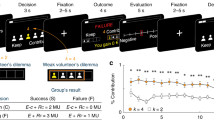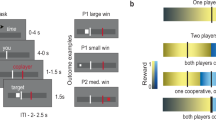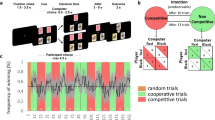Abstract
In a multi-agent environment, where the outcomes of one's actions change dynamically because they are related to the behavior of other beings, it becomes difficult to make an optimal decision about how to act. Although game theory provides normative solutions for decision making in groups, how such decision-making strategies are altered by experience is poorly understood. These adaptive processes might resemble reinforcement learning algorithms, which provide a general framework for finding optimal strategies in a dynamic environment. Here we investigated the role of prefrontal cortex (PFC) in dynamic decision making in monkeys. As in reinforcement learning, the animal's choice during a competitive game was biased by its choice and reward history, as well as by the strategies of its opponent. Furthermore, neurons in the dorsolateral prefrontal cortex (DLPFC) encoded the animal's past decisions and payoffs, as well as the conjunction between the two, providing signals necessary to update the estimates of expected reward. Thus, PFC might have a key role in optimizing decision-making strategies.
This is a preview of subscription content, access via your institution
Access options
Subscribe to this journal
Receive 12 print issues and online access
$209.00 per year
only $17.42 per issue
Buy this article
- Purchase on Springer Link
- Instant access to full article PDF
Prices may be subject to local taxes which are calculated during checkout






Similar content being viewed by others
References
Von Neumann, J. & Morgenstern, O. Theory of Games and Economic Behavior (Princeton Univ. Press, New Jersey, 1944).
Fudenberg, D. & Tirole, J. Game Theory (MIT Press, Cambridge, Massachusetts, 1991).
Dixit, A. & Skeath, S. Games of Strategy (Norton, New York, 1999).
Glimcher, P.W. Decisions, Uncertainty, and the Brain (MIT Press, Cambridge, Massachusetts, 2003).
Nash, J.F. Equilibrium points in n-person games. Proc. Natl. Acad. Sci. USA 36, 48–49 (1950).
Robinson, J. An iterative method of solving a game. Ann. Math. 54, 296–301 (1951).
Binmore, K., Swierzbinski, J. & Proulx, C. Does minimax work? An experimental study. Econ. J. 111, 445–464 (2001).
Touhey, J.C. Decision processes, expectations, and adoption of strategies in zero-sum games. Hum. Relat. 27, 813–824 (1974).
O'Neill, B. Nonmetric test of the minimax theory of two-person zerosum games. Proc. Natl. Acad. Sci. USA 84, 2106–2109 (1987).
Brown, J.N. & Rosenthal, R.W. Testing the minimax hypothesis: a re-examination of O'Neill's game experiment. Econometrica 58, 1065–1085 (1990).
Rapoport, A. & Boebel, R.B. Mixed strategies in strictly competitive games: a further test of the minimax hypothesis. Games Econ. Behav. 4, 261–283 (1992).
Rapoport, A. & Budescu, D.V. Generation of random series in two-person strictly competitive games. J. Exp. Psychol. Gen. 121, 352–363 (1992).
Budescu, D.V. & Rapoport, A. Subjective randomization in one- and two-person games. J. Behav. Dec. Making 7, 261–278 (1994).
Ochs, J. Games with unique, mixed strategy equilibria: an experimental study. Games Econ. Behav. 10, 202–217 (1995).
Sarin, R. & Vahid, F. Predicting how people play games: a simple dynamic model of choice. Games Econ. Behav. 34, 104–122 (2001).
Shachat, J.M. Mixed strategy play and the minimax hypothesis. J. Econ. Theory 104, 189–226 (2002).
Walker, M. & Wooders, J. Minimax play at Wimbledon. Am. Econ. Rev. 91, 1521–1538 (2001).
Fudenberg, D. & Levine, D.K. Theory of Learning in Games (MIT Press, Cambridge, Massachusetts, 1998).
Mookherjee, D. & Sopher, B. Learning behavior in an experimental matching pennies game. Games Econ. Behav. 7, 62–91 (1994).
Erev, I. & Roth, A.E. Predicting how people play games: reinforcement learning in experimental games with unique, mixed strategy equilibria. Am. Econ. Rev. 88, 848–881 (1998).
Camerer, C.F. Behavioral Game Theory (Princeton Univ. Press, Princeton, New Jersey, 2003).
Simon, H.A. Models of Man (Wiley, New York, 1957).
Kahneman, D., Slovic, P. & Tversky, A. Judgement Under Uncertainty: Heuristics and Biases (Cambridge Univ. Press, Cambridge, UK, 1982).
O'Neill, B. Comments on Brown and Rosenthal's reexamination. Econometrica 59, 503–507 (1991).
Rapoport, A. & Budescu, D.V. Randomization in individual choice behavior. Psychol. Rev. 104, 603–617 (1997).
Chen, H-C., Friedman, J.W. & Thisse, J-F. Boundedly rational Nash equilibrium: a probabilistic choice approach. Games Econ. Behav. 18, 32–54 (1997).
Rubinstein, A. Modeling Bounded Rationality (MIT Press, Cambridge, Massachusetts, 1998).
Sutton, R.S. & Barto, A.G. Reinforcement Learning: an Introduction (MIT Press, Cambridge, Massachusetts, 1998).
Littman, M.L. Markov games as a framework for multi-agent reinforcement learning. Machine Learning: Proc. 11th Int. Conf. pp. 157–163 (Morgan Kaufmann, San Francisco, California, 1994).
Christensen, R. Log-linear Models and Logistic Regression edn. 2 (Springer-Verlag, New York, 1997).
Burnham, K.P. & Anderson, D.R. Model Selection and Multimodel Inference 2nd edn. (Springer-Verlag, New York, 2002).
Byrne, R.W. & Whiten, A. Machiavellian Intelligence: Social Expertise and the Evolution of Intellect in Monkeys, Apes and Humans (Oxford Univ. Press, Oxford, UK, 1988).
Whiten, A. & Byrne, R.W. Machiavellian Intelligence II: Extensions and Evaluations (Cambridge Univ. Press, Cambridge, UK, 1997).
Schultz, W. Predictive reward signal of dopamine neurons. J. Neurophysiol. 80, 1–27 (1998).
Rolls, E.T. Brain and Emotion (Oxford Univ. Press, Oxford, UK, 1999).
Amador, N., Schlag-Rey, M. & Schlag, J. Reward-predicting and reward detecting neuronal activity in the primate supplementary eye field. J. Neurophysiol. 84, 2166–2170 (2000).
Stuphorn, V., Taylor, T.L. & Schall, J.D. Performance monitoring by the supplementary eye field. Nature 408, 857–860 (2000).
Ito, S., Stuphorn, V., Brown, J.W. & Schall, J.D. Performance monitoring by the anterior cingulate cortex during saccade countermanding. Science 302, 120–122 (2003).
Kawagoe, R., Takikawa, Y. & Hikosaka, O. Expectation of reward modulates cognitive signals in the basal ganglia. Nat. Neurosci. 1, 411–416 (1998).
Platt, M.L. & Glimcher, P.W. Neural correlates of decision variables in parietal cortex. Nature 400, 233–238 (1999).
Shidara, M. & Richmond, B.J. Anterior cingulate: single neuronal signals related to degree of reward expectancy. Science 296, 1709–1711 (2002).
Ikeda, T. & Hikosaka, O. Reward-dependent gain and bias of visual responses in primate superior colliculus. Neuron 39, 693–700 (2003).
McCoy, A.N., Crowley, J.C., Haghighian, G., Dean, H.L. & Platt, M.L. Saccade reward signals in posterior cingulate cortex. Neuron 40, 1031–1040 (2003).
Watanabe, M. Reward expectancy in primate prefrontal cortex. Nature 382, 629–632 (1996).
Leon, M.I. & Shadlen, M.N. Effect of expected reward magnitude on the response of neurons in the dorsolateral prefrontal cortex of the macaque. Neuron 24, 415–425 (1999).
Kobayashi, S., Lauwereyns, J., Koizumi, M., Sakagami, M. & Hikosaka, O. Influence of reward expectation on visuospatial processing in macaque lateral prefrontal cortex. J. Neurophysiol. 87, 1488–1498 (2002).
Roesch, M.R. & Olson, C.R. Impact of expected reward on neuronal activity in prefrontal cortex, frontal and supplementary eye fields and premotor cortex. J. Neurophysiol. 90, 1766–1789 (2003).
Tsujimoto, S. & Sawaguchi, T. Neuronal representation of response outcome in the primate prefrontal cortex. Cereb. Cortex 14, 47–55 (2004).
Wang, X.-J. Probabilistic decision making by slow reverberation in cortical circuits. Neuron 36, 955–968 (2002).
Bruce, C.J., Goldberg, M.E., Bushnell, M.C. & Stanton, G.B. Primate frontal eye fields. II. Physiological and anatomical correlates of electrically evoked eye movements. J. Neurophysiol. 54, 714–734 (1985).
Acknowledgements
We thank L. Carr, R. Farrell, B. McGreevy and T. Twietmeyer for their technical assistance, J. Swan-Stone for programming, X.-J. Wang for discussions, and B. Averbeck and J. Malpeli for critically reading the manuscript. This work was supported by the James S. McDonnell Foundation and the National Institutes of Health (NS44270 and EY01319).
Author information
Authors and Affiliations
Corresponding author
Ethics declarations
Competing interests
The authors declare no competing financial interests.
Rights and permissions
About this article
Cite this article
Barraclough, D., Conroy, M. & Lee, D. Prefrontal cortex and decision making in a mixed-strategy game. Nat Neurosci 7, 404–410 (2004). https://doi.org/10.1038/nn1209
Received:
Accepted:
Published:
Issue Date:
DOI: https://doi.org/10.1038/nn1209
This article is cited by
-
Neural ensembles in the murine medial prefrontal cortex process distinct information during visual perceptual learning
BMC Biology (2023)
-
Bayesian prediction of psychophysical detection responses from spike activity in the rat sensorimotor cortex
Journal of Computational Neuroscience (2023)
-
A computational model of inner speech supporting flexible goal-directed behaviour in Autism
Scientific Reports (2022)
-
Best Reply Player Against Mixed Evolutionarily Stable Strategy User
Bulletin of Mathematical Biology (2022)
-
Adolescent reinforcement-learning trajectories predict cocaine-taking behaviors in adult male and female rats
Psychopharmacology (2022)



